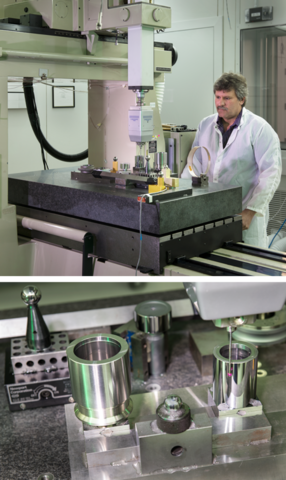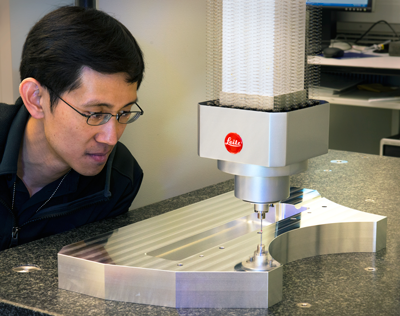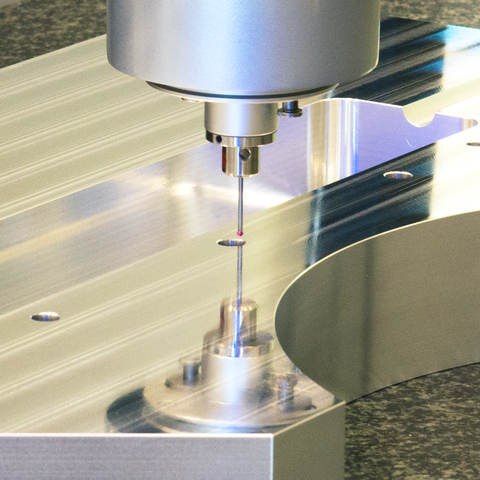
Top: PML Dimensional Metrology Group’s John Stoup making measurements of the piston gauge using a coordinate measuring machine (CMM). Bottom: The piston (right) and its cylindrical sleeve (left) in a CMM at NIST. Notice the red ruby tip of the probe (right).
Last fall, PML researchers built and tested the first-ever photonic pressure sensor, which makes its measurements using light.
This sensor, called the Fixed-Length Optical Cavity (FLOC)*, was smaller and faster than the current national pressure standard – a 3-meter-tall mercury manometer based on NIST's Gaithersburg campus – while maintaining high accuracy and resolution, just weeks after being turned on for the first time.
Now the interdisciplinary team that built the FLOC, with members from the Thermodynamic Metrology Group and the Dimensional Metrology Group, is beginning construction of a second design, this one for a photonic pressure standard: the Variable-Length Optical Cavity (VLOC), which has a good chance of eventually replacing the mercury manometer as the standard pressure gauge by which other sensors are calibrated.
When complete, the VLOC will be about 1 meter long with a platform near its base that can slide in and out. Connected to this platform will be a stretchable tube that can be made longer or shorter depending on the platform's position. The tube is filled with helium gas; the rest of the VLOC will be under vacuum.
Researchers will make pressure measurements by gauging changes to the frequency of the laser light traveling through this helium-filled tube.
PML's Dimensional Metrology Group has recently provided critical dimensional measurements in support of this effort, using coordinate measuring machines (CMMs) that can detect changes in position as small as ten billionths of a meter (10 nanometers, nm).
The first measured piece was a two-foot-long (about 55 x 35 x 5 cm) aluminum side plate that will support the sliding platform. Each side plate – there will eventually be two of them – needs to be extremely flat to keep the platform moving along a straight line.

A second set of dimensional measurements evaluated a piston gauge, which consists of a piston and the cylindrical sleeve in which it slowly falls, generating a predictable pressure. The idea is to use this custom piston gauge to generate a well-known pressure that the VLOC can measure.
Because the air gap between the piston and its sleeve increases the uncertainty in the amount of pressure it generates, the team designed the gap to be as uniform and narrow as possible – only hundreds of nanometers across, with roundness and straightness as good as possible within the limits of precision manufacturing.

The basic principle on which the VLOC operates is that the frequency of the laser light inside the gas-filled tube depends on pressure, temperature, and the gas's refractive index. With a constant temperature, the researchers can use the VLOC to measure the refractive index of helium to within a few parts in 100 billion. Theoretical calculations relate the refractive index to pressure, allowing pressure to be inferred from the measurement.
A precise measurement of helium's index of refraction then allows the team to use the VLOC device to make pressure measurements that rival or surpass those that can be made by the mercury manometer standard.
Both teams are pleased with the dimensional metrology results.
"Their measurements will allow us to make best-in-the-world index of refraction measurements," says Thermodynamic Metrology Group's Jacob Ricker. "If we improve our measurement of the index of refraction of helium, then we can improve our photonic standard until it's better than the current mercury standard, and then we won't need the mercury manometer anymore."
-- Reported and written by Jennifer Lauren Lee
*For information about the Fixed-Length Optical Cavity (FLOC) pressure sensor, see "World's First Photonic Pressure Sensor Outshines Traditional Mercury Standard."

